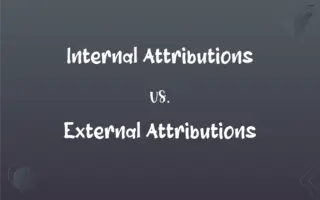Michaelis Menten Plot vs. Lineweaver Burk Plot: What's the Difference?
Edited by Aimie Carlson || By Harlon Moss || Published on February 28, 2024
Michaelis-Menten plots show enzyme kinetics as a hyperbolic curve, while Lineweaver-Burk plots linearize these kinetics to calculate enzyme parameters more precisely.

Key Differences
The Michaelis-Menten plot graphically represents the relationship between the rate of an enzyme-catalyzed reaction and substrate concentration, typically forming a hyperbolic curve. The Lineweaver-Burk plot, a linear transformation of the Michaelis-Menten equation, plots the inverse of these variables.
In a Michaelis-Menten plot, the reaction rate steadily increases with substrate concentration until it reaches a maximum. In contrast, the Lineweaver-Burk plot linearly represents this relationship, making it easier to determine kinetic constants like Vmax and Km.
The Michaelis-Menten plot is more intuitive for visualizing enzyme activity but can be less accurate for calculating kinetic parameters. The Lineweaver-Burk plot, though more complex, provides a clearer analysis of enzyme kinetics, especially in cases of low substrate concentration.
Michaelis-Menten plots are widely used due to their straightforward representation of enzyme kinetics. However, the Lineweaver-Burk plot is often preferred in academic and research settings for its precision in determining enzymatic properties.
The Michaelis-Menten plot is ideal for a general understanding of enzyme behavior, the Lineweaver-Burk plot excels in its ability to accurately extrapolate important kinetic constants like Km (Michaelis constant) and Vmax (maximum velocity).
ADVERTISEMENT
Comparison Chart
Graphical Representation
Hyperbolic curve
Straight line
Focus
Visualizing enzyme activity and substrate concentration
Calculating enzyme kinetic constants (Km and Vmax)
Plot Axes
Rate of reaction vs. substrate concentration
Inverse of rate of reaction vs. inverse of substrate concentration
Use Case
General understanding of enzyme kinetics
Precise determination of enzyme kinetics
Complexity
Simpler, more intuitive
More complex, requires transformation of data
ADVERTISEMENT
Michaelis Menten Plot and Lineweaver Burk Plot Definitions
Michaelis Menten Plot
Used to estimate the maximal rate of reaction and Michaelis constant.
From the Michaelis-Menten plot, we approximated the Km value for the enzyme.
Lineweaver Burk Plot
It's used to determine kinetic constants like Km and Vmax more accurately.
By analyzing the Lineweaver-Burk plot, we accurately calculated the enzyme's Vmax.
Michaelis Menten Plot
It illustrates how reaction rate reaches a maximum at high substrate concentrations.
Using the Michaelis-Menten plot, we observed the plateau of the reaction rate.
Lineweaver Burk Plot
Useful in identifying the type of enzyme inhibition.
The slope change in the Lineweaver-Burk plot indicated competitive inhibition.
Michaelis Menten Plot
A graphical representation of the rate of an enzyme-catalyzed reaction against substrate concentration.
The Michaelis-Menten plot showed a typical hyperbolic pattern as the substrate concentration increased.
Lineweaver Burk Plot
Often used in research settings for detailed enzyme kinetics studies.
Our study's detailed kinetic analysis relied on data from a Lineweaver-Burk plot.
Michaelis Menten Plot
Shows the saturation of enzyme active sites at high substrate levels.
The Michaelis-Menten plot clearly demonstrated enzyme saturation.
Lineweaver Burk Plot
Plots the inverse of substrate concentration against the inverse of reaction rate.
In the Lineweaver-Burk plot, the y-intercept gave us the inverse of Vmax.
Michaelis Menten Plot
This plot is useful for visualizing basic enzyme kinetics.
To understand the enzyme's behavior, we constructed a Michaelis-Menten plot.
Lineweaver Burk Plot
A double reciprocal plot that linearizes the relationship between enzyme activity and substrate concentration.
The Lineweaver-Burk plot provided a clear linear relationship for enzyme kinetics analysis.
FAQs
What is a Lineweaver-Burk plot used for?
It's used for accurately calculating enzyme kinetic constants like Km and Vmax.
What does a Michaelis-Menten plot show?
It shows the relationship between enzyme reaction rate and substrate concentration.
What is the main advantage of a Lineweaver-Burk plot?
It linearizes enzyme kinetics data for more precise analysis.
Can Michaelis-Menten plots estimate Vmax?
Yes, but it's an approximation.
How is the Michaelis-Menten plot typically shaped?
It typically has a hyperbolic shape.
Why convert a Michaelis-Menten plot to a Lineweaver-Burk plot?
To transform the nonlinear relationship into a linear one for easier analysis.
How does a Lineweaver-Burk plot represent enzyme inhibition?
Changes in the plot's slope and intercepts can indicate the type and extent of inhibition.
What does the Km value represent in these plots?
Km is the substrate concentration at which the reaction rate is half of Vmax.
What is the primary limitation of a Michaelis-Menten plot?
It can be less accurate for calculating exact kinetic parameters.
Why might a Lineweaver-Burk plot not be used?
Its complexity and potential for data distortion at very high or low substrate concentrations.
How is Vmax determined from a Lineweaver-Burk plot?
By taking the reciprocal of the y-intercept.
Can Lineweaver-Burk plots be used for all types of inhibition?
Yes, they can help distinguish between different types of enzyme inhibitors.
Is the Michaelis-Menten plot suitable for all enzymes?
It's suitable for most, but not all, as some enzymes exhibit non-Michaelis-Menten kinetics.
Are these plots used in real-world applications?
Yes, they're widely used in biochemistry and pharmaceutical research.
Is one plot more accurate than the other?
The Lineweaver-Burk plot is generally considered more accurate for calculating kinetic constants.
Can these plots be used for multi-substrate enzymes?
Yes, but with more complex modifications and interpretations.
Can these plots determine enzyme efficiency?
Yes, both plots can give insights into enzyme efficiency.
What impact does enzyme concentration have on these plots?
Enzyme concentration affects the rate of reaction but does not change Vmax.
How do substrate concentration changes appear in a Lineweaver-Burk plot?
As different lines with varying slopes and intercepts on the plot.
What does a steeper slope in a Michaelis-Menten plot indicate?
A higher Km value, suggesting lower enzyme affinity for the substrate.
About Author
Written by
Harlon MossHarlon is a seasoned quality moderator and accomplished content writer for Difference Wiki. An alumnus of the prestigious University of California, he earned his degree in Computer Science. Leveraging his academic background, Harlon brings a meticulous and informed perspective to his work, ensuring content accuracy and excellence.
Edited by
Aimie CarlsonAimie Carlson, holding a master's degree in English literature, is a fervent English language enthusiast. She lends her writing talents to Difference Wiki, a prominent website that specializes in comparisons, offering readers insightful analyses that both captivate and inform.
































































